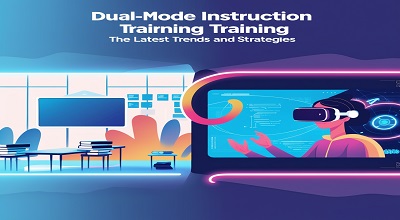Dual-Mode Instruction Training
In the ever-evolving landscape of education, dual-mode instruction training has emerged as a revolutionary approach to teaching and learning. Combining the best of in-person and online learning, this hybrid model offers flexibility, accessibility, and enhanced engagement for both educators and students.
At TeacherEducator.com, we explore the latest advancements, benefits, challenges, and best practices in dual-mode instruction training. Whether you’re an educator, administrator, or ed-tech enthusiast, this comprehensive guide will provide valuable insights into how dual-mode instruction is shaping the future of education.
What is Dual-Mode Instruction Training?
Definition and Key Components
Dual-mode instruction training refers to an educational approach that simultaneously delivers content through both in-person and online platforms. This model allows learners to choose their preferred mode of instruction while ensuring continuity in education.
Key components include:
- Synchronous Learning: Live sessions (virtual or in-person).
- Asynchronous Learning: Pre-recorded lectures, discussion forums, and digital resources.
- Blended Assessments: Online quizzes, in-person exams, and project-based evaluations.
Evolution of Dual-Mode Learning
Initially, dual-mode learning was limited to distance education programs. However, with advancements in EdTech, AI, and cloud-based platforms, it has become a mainstream approach in K-12, higher education, and corporate training.
The COVID-19 pandemic accelerated its adoption, forcing institutions to rethink traditional teaching models. Today, dual-mode instruction is a permanent fixture in modern education.
Benefits of Dual-Mode Instruction Training
Flexibility for Learners and Educators
- Students can attend classes in-person or remotely based on their schedules.
- Educators can record lectures for later review, reducing repetitive teaching.
Increased Accessibility and Inclusivity
- Breaks geographical barriers, allowing global participation.
- Supports students with disabilities through customizable learning tools.
Cost-Effectiveness for Institutions
- Reduces infrastructure costs (fewer physical classrooms needed).
- Scalable for large student populations.
Latest Trends in Dual-Mode Instruction
AI-Powered Adaptive Learning
AI algorithms personalize learning experiences by analyzing student performance and recommending tailored content.
Gamification in Hybrid Classrooms
- Badges, leaderboards, and interactive quizzes boost engagement.
- Tools like Kahoot! and Classcraft enhance participation.
Virtual and Augmented Reality (VR/AR) Integration
- VR labs for science experiments.
- AR simulations for medical training.
Challenges and Solutions
Technical Barriers and Infrastructure Needs
- Challenge: Not all students have reliable internet or devices.
- Solution: Institutions can provide loaner devices and offline resources.
Maintaining Student Engagement
- Challenge: Online learners may feel disconnected.
- Solution: Use interactive polls, breakout rooms, and discussion boards.
Assessment and Evaluation in Hybrid Learning
- Challenge: Preventing cheating in online exams.
- Solution: Proctoring software and project-based assessments.
Best Practices for Implementing Dual-Mode Instruction
Effective Use of Learning Management Systems (LMS)
- Platforms like Moodle, Canvas, and Blackboard streamline content delivery.
Training Educators for Hybrid Teaching
- Professional development on digital pedagogy and tech tools.
Student-Centered Instructional Design
- Focus on active learning, peer collaboration, and self-paced modules.
Case Studies: Successful Dual-Mode Programs
Universities Leading the Way
- Harvard Extension School: Hybrid degrees with online and on-campus options.
- Arizona State University (ASU): Fully integrated digital immersion programs.
Corporate Training Adaptations
- Google Career Certificates: Self-paced online courses with live mentorship.
Future of Dual-Mode Instruction Training
Predictions for the Next Decade
- More AI-driven personalization.
- Growth of micro-credentials and stackable degrees.
The Role of EdTech Innovations
- Blockchain for credentialing.
- Holographic teachers for immersive learning.
Conclusion
Dual-mode instruction training is transforming education by merging the best of traditional and digital learning. As technology evolves, institutions must adapt and innovate to meet learner needs.
More Here: DX Mod Pro APK
